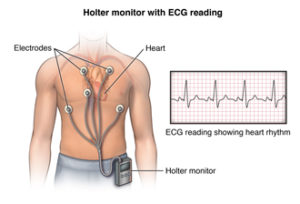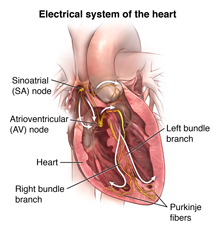What is a Holter monitor?
The Holter monitor is a type of electrocardiogram (ECG or EKG) used to monitor the ECG tracing continuously for a period of 24 hours or longer. A standard or “resting” ECG is one of the simplest and fastest procedures used to evaluate the heart. Electrodes (small, plastic patches) are placed at certain locations on the chest and abdomen. When the electrodes are connected to an ECG machine by lead wires, the electrical activity of the heart is measured, interpreted, and printed out for the doctor’s information and further interpretation.
When symptoms, such as dizziness, fainting, low blood pressure, prolonged fatigue, and palpitations, continue to occur without a definitive diagnosis obtained with a resting ECG, your doctor may request an ECG tracing to be run over a long period of time, using the Holter monitor.

Certain dysrhythmias and arrhythmias (abnormal heart rhythms), which can cause the symptoms noted above, may occur only intermittently, or may occur only under certain conditions, such as stress. Dysrhythmias of this type are difficult to obtain on an ECG tracing that only runs for a few minutes. Thus, the doctor will request a Holter monitor to allow a better opportunity to capture any abnormal heartbeats or rhythms that may be causing the symptoms. The Holter monitor records continuously for the entire period of 24 to 48 hours. Some Holter monitors may record continuously but also have an event monitor feature that you activate when symptoms begin to occur.
You will receive instructions regarding how long you will need to wear the recorder (usually 24 to 48 hours), how to keep a diary of your activities and symptoms during the test, and personal care and activity instructions, which include keeping the device dry while you are wearing it.
What is an event monitor?
Event monitoring is very similar to Holter monitoring, and is often ordered for the same reasons. With an event monitor, you wear ECG electrode patches on your chest, and the electrodes are connected by wire leads to a recording device. Unlike the Holter monitor, however, which records continuously throughout the testing period of 24 to 48 hours, the event monitor records when you feel symptoms and trigger the monitor to record your ECG tracing at that time. An auto-trigger event monitor may be used to record rhythms when symptoms are rare or suspected to occur during sleep. The auto-trigger event monitor automatically records rhythm events that are faster or slower than normal and can also be manually activated if you experience symptoms.
When you feel one or more symptoms, such as chest pain, dizziness, or palpitations, you push a button on the event monitor recorder. Some monitors have a feature (memory loop recorder) which captures a short period of time prior to the moment you triggered the recording and afterwards. This feature can help your doctor determine more details about the possible change in your ECG at the time the symptoms started, and what was happening with your ECG just before you triggered the recorder. Other monitors, called “post-event recorders,” simply start recording your ECG from the moment you trigger it.
Post-event recorders are quite small and some may even be worn on the wrist (similar to a wristwatch). Memory-loop recorders are about the size of a pager.
After you experience symptoms and record them, you will send the recording of the event to your doctor or to a central monitoring center. This transmission is generally done over the telephone or wirelessly using cellular technology. You will be instructed regarding how to transmit data. You will also keep a diary of your symptoms and corresponding activities (as done during the Holter monitoring procedure).
The heart’s electrical conduction system
The heart is, in the simplest terms, a pump made up of muscle tissue. The heart’s pumping action is regulated by an electrical conduction system that coordinates the contraction of the various chambers of the heart.

An electrical stimulus is generated by the sinus node (also called the sinoatrial node, or SA node), which is a small mass of specialized tissue located in the right atrium (right upper chamber) of the heart.
The sinus node generates an electrical stimulus regularly at 60 to 100 times per minute under normal conditions. This electrical stimulus travels down through the conduction pathways (similar to the way electricity flows through power lines from the power plant to your house) and causes the heart’s lower chambers to contract and pump out blood. The right and left atria (the two upper chambers of the heart) are stimulated first and contract a short period of time before the right and left ventricles (the two lower chambers of the heart).
The electrical impulse travels from the sinus node to the atrioventricular node (also called AV node), where impulses are slowed down for a very short period, then continue down the conduction pathway via the bundle of His into the ventricles. The bundle of His divides into right and left pathways to provide electrical stimulation to the right and left ventricles.
This electrical activity of the heart is measured by an electrocardiogram. By placing electrodes at specific locations on the body (chest, arms, and legs), a graphic representation, or tracing, of the electrical activity can be obtained. Changes in an ECG from the normal tracing may indicate one or more of several heart-related conditions.
Reasons for the procedure
Some reasons for your doctor to request a Holter monitor recording or event monitor recording include, but are not limited to, the following:
- To evaluate chest pain not reproduced with exercise testing
- To evaluate other signs and symptoms that may be heart-related, such as fatigue, shortness of breath, dizziness, or fainting
- To identify irregular heartbeats or palpitations
- To assess risk for future heart-related events in certain conditions, such as idiopathic hypertrophic cardiomyopathy (pathologically thickened heart walls due to an underlying genetic condition), post-heart attack with weakness of the left side of the heart, or Wolff-Parkinson-White syndrome (where an abnormal electrical conduction pathway exists within the heart)
- To assess the function of an implanted pacemaker
- To determine the effectiveness of therapy for complex arrhythmias
There may be other reasons for your doctor to recommend the use of a Holter monitor.
Risks of the procedure
The Holter monitor is a noninvasive method of assessing the heart’s function. Risks associated with the Holter monitor are rare.
Prolonged application of the adhesive electrode patches may cause tissue breakdown or skin irritation at the application site.
There may be other risks depending on your specific medical condition. Be sure to discuss any concerns with your doctor prior to wearing the monitor.
Certain factors or conditions may interfere with or affect the results of the Holter monitor reading. These include, but are not limited to, the following:
- Close proximity to magnets, metal detectors, high-voltage electrical wires, and electrical appliances such as shavers, toothbrushes, and hair dryers
- Smoking, certain medications
- Excessive perspiration, which may cause the leads to loosen or detach
Before the procedure:
- Your doctor will explain the procedure to you and offer you the opportunity to ask any questions that you might have about the reading.
- Fasting is not required.
- Based on your medical condition, your doctor may request other specific preparation.
During the procedure
A Holter monitor recording is generally performed on an outpatient basis. Procedures may vary depending on your condition and your doctor’s practices.
Generally, a Holter monitor recording follows this process:
- You will be asked to remove any jewelry or other objects that may interfere with the reading.
- You will be asked to remove clothing from the waist up in order to attach the electrodes to your chest. The technician will ensure your privacy by covering you with a sheet or gown and exposing only the necessary skin.
- The areas where the electrodes patches are placed are cleaned, and in some cases, hair may be shaved or clipped so that the electrodes will stick closely to the skin.
- Electrodes will be attached to your chest and abdomen. The Holter monitor will be connected to the electrodes with lead wires. The monitor box may be worn over the shoulder like a shoulder bag, or it may clip to a belt or pocket.
- Once you have been hooked up to the monitor and given instructions, you can return to your usual activities, such as work, household chores, and exercise, unless your doctor instructs you differently. This will allow your doctor to identify problems that may only occur with certain activities.
- You will be instructed to keep a diary of your activities during the recording period. You should write down the date and time of your activities, particularly if any symptoms, such as dizziness, palpitations, chest pain, or other previously-experienced symptoms, occur.
After the procedure
You should be able to resume your normal diet and activities, unless your doctor instructs you differently.
Generally, there is no special care following a Holter monitor recording.
Notify your doctor if you develop any signs or symptoms you had prior to the recording (for example, chest pain, shortness of breath, dizziness, or fainting).
Your doctor may give you additional or alternate instructions after the procedure, depending on your particular situation.
